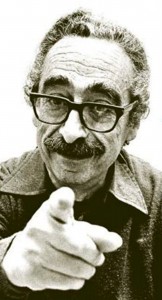If you already know about this project, you’ll find the Parent texts here. If you want to learn more, please read below.
Manuel de Pedrolo (1918-1990) was a widely published Catalan writer, whose 1974 novel Mecanoscrit del segon origen became one of the most read Catalan works of the 20th Century. He was certainly the most prolific writer during and after Franco’s 40-year-long totalitarian regime, probably the darkest moment in Catalan history. By producing more than 150 works in a time when speaking and writing in Catalan was prohibited in Catalonia, Pedrolo became a key figure in the revitalization and promotion of Catalan literature and culture.
The project Temps Obert v 11.1 is named after one of Pedrolo’s major works, considered his masterpiece by many Catalan scholars. “Temps Obert” is an ambitious novelistic cycle that not only exemplifies Pedrolo’s experimental narrative techniques, but also stands out as his literary manifesto. With “Temps Obert”, Pedrolo tried to approach the idea of “novela total” through an eleven book cycle. The first volume of the cycle, Un camí amb Eva (Temps obert 1) introduces the reader to Daniel Bastida, a character who grows up in the midst of the civil war and is brought up by a middle class Catalan family in Barcelona.
Through the other 10 books in the collection, Pedrolo showcases a range of parallel narratives, created by the introduction of slight changes in the original plot in some cases, or mainly modifying the point of view from which the story is told in others. The stories, with Daniel Bastida as their main character, depict the postwar years’ living conditions in Barcelona from a multi-angled perspective.
Temps Obert v. 11
Our project starts as a new interpretation of Pedrolo’s concept of “novela total”, in which different writers write their own independent story in their own language, but collide every Monday in the following manner:
- All writers write one fragment of their story (350-400 words) per week. Writing days are Mondays (with only one person writing) and Fridays (with the rest of writers contributing)
- Texts written on Monday are called “Parent texts”. These influence or give ideas to Friday writers, who will slightly adapt their narratives by including a reference to the Parent one, such as a theme, a motif, a feeling, a situation, a stylistic technique, a character, a color, an idea… anything that indicates that their creative process has been clearly influenced by it.
- The person in charge of writing the Parent text rotates every week, giving the chance of being the Parent writer to someone different each Monday. That means that the direction of the story is driven by every writer at some point; here lies the true collaborative nature of the project.
- Every writer creates and gives continuity to his/her own story. This means that every week, whether you are the Parent writer or not, your text will have to be a continuation of your previous week narrative. All writers have the freedom to bring their stories wherever they want to; the challenging part is being able to integrate the Parent text in their stories in the most original possible way.
- The riskier the turn in your story is, the more challenging it will be for the other writers to follow your steps; the less conventional the stylistic approach, the harder they will have to try to adapt their stories to yours. The key is getting as close as you can to the parent text without making your own text lose its own identity; the limit is your imagination and writing skills!
- At this point, you may ask yourself: how can you as a writer relate to a Catalan, a Swedish, a Galician, an English and a Spanish text? Do you necessarily have to be fluent in these languages to contribute to the project? The answer is simple: No! The only language required apart from your native tongue will be English, as all Parent texts are translated into this language by their creators.
“The Creature” is the text created when putting together all Parent texts. As you may intuit after the explanation above, the resulting text will present the same patched complexion as the body of “The Creature” created by Victor Frankenstein in Mary Shelley’s novel.
Built out of the best pieces of different men, Mary Shelley’s creature was not able to live in isolation, but instead had to search for answers/meanings in his creator.
In the same way, these connected but also dislocated texts present themselves as an interesting experiment to look at, but will obviously make more sense when seen in their own context, together with the other fragments written in the same language.
Collaborate with Temps Obert
You can always contribute to the project by commenting on your favorite posts in your native language, always trying to follow the steps outlined above to write your 350-400 words piece.
However, if you enjoy creative writing enough to become a regular contributor and are a native speaker of a language that is still not featured in our project, please write an email to pfernandez@ucc.ie with a 350-400 words text you created (both in English and your native language), influenced by one of the last published Parent texts.




